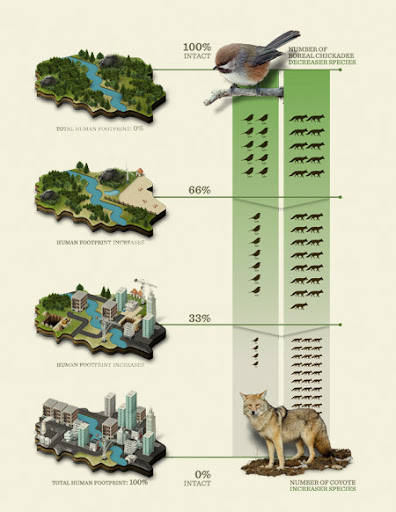Here at the ABMI, we spend a lot of time thinking about large-scale changes to biodiversity and landscapes across Alberta. A core part of our work asks: what impacts does the human footprint of land use activities (like forestry, energy, agriculture) have in our province? Back in 2007, in our early days of data collection and research, we knew we needed a clear and concise way to measure and report on changes in biodiversity due to land-use pressures, so researchers at the ABMI developed and launched the Biodiversity Intactness Index (which we refer to as “Intactness” or “the index”).
In general, an intactness index uses a breadth of species and remotely sensed data to predict how species are responding to land-use change. The ABMI was not the first to report on intactness; this type of indicator was proposed as early as 2005 (A biodiversity intactness index; R.J. Scholes and R Biggs) and has been used to answer questions about the status of biodiversity at both local (Neisen et al., 2007) and global (De Palma et al., 2021) scales. Although several versions of intactness indices can be found in the published literature, all have the common goal of tracking changes in species abundance relative to a reference condition. The ABMI’s index is parameterized using field data from across the province, is fully scalable, and is easily calculable (and you can play around with it HERE on our mapping portal by clicking on select layers, then datasets, then species).
The index can be used to identify areas of intact biodiversity, understand how different types of land use may impact biodiversity, and what land-use changes mean to individual species at the regional scale. Having this scientifically defensible indicator that can track changes in biodiversity over time supports better informed and current land-use management.
How does it work?
Intactness is a metric that provides an estimate of how much a species’ relative abundance has changed from the level expected in the absence of human development. For example, the absence of human development on a landscape could mean a large patch of forest with no buildings, transmission lines, or roads. Deviations in abundance in either direction (i.e., more or less abundant) means lower intactness. We categorize species as “increasers” or “decreasers.” Coyotes, crows, and certain types of invasive plants are increasers—these species are adaptable and are able to thrive in more human-altered environments.

Coyote (Canis latrans) Photo: TBD
Boreal Chickadees, Brown Creepers and Marten are examples of decreaser species sensitive to changes in their environment and often unable to adapt.

The ABMI Biodiversity Intactness Index
Since 2007, Intactness has undergone multiple enhancements, including the addition of new taxa, refining land-use pressures on species, and incorporating data from outside of the ABMI’s monitoring program.
Biodiversity is an intricate interplay of relationships, and when the surrounding environment is changed, the ecosystems and their inhabitants may change. This index is key for understanding these relationships between landscape, species, and development.
Without it, we wouldn’t be able to take the approximately 1.7 million field specimens, 72 million camera trap photos, and 190 recording years of vocalizing species (from birds, to wolves, to frogs) we’ve collected and turn them into an understandable metric for how the seven taxonomic groups we monitor are doing in response to land-use change. Specifically, we use it to report on the status of biodiversity in Alberta on a variety of scales, from the status of biodiversity in a specific natural region or Forest Management Area, to the status of biodiversity in wetlands across Alberta in the Wetland Atlas of Alberta.
On September 27 @ noon Mountain Time, join ABMI Applied Ecologist Brandon Allen for a free webinar as he speaks to the evolution and applications, and the details of the underlying methodology, of the ABMI’s Biodiversity Intactness Index.
The webinar is free, but please RSVP here so we know to expect you. The webinar will also be archived on our YouTube channel if you can’t make the live event, or just want to relive all the action.

